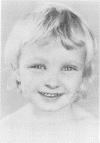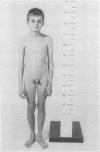Abstract
The features of a child with Ehlers-Danlos syndrome type IV (EDS IV) resulting from a mutation in one COL3A1 allele were studied. The child was heterozygous for a G- to A-transition at the splice donor site of intron 41. It resulted in the splicing out of the exon 41 encoded sequence from alpha 1(III) mRNA and the deletion of 36 amino acids from glycine775 to lysine810 of the triple helical domain of alpha 1(III) chains of type III collagen. The amount of type III collagen in the dermis was only about 11% of normal. The child had the acrogeric form of EDS IV. He had the characteristic facies with a pinched nose, thin lips, and prominent eyes. These facial features, his aesthenic build, thin skin, prominent subcutaneous veins, and aged hands produced a 'cachectic' appearance. These features were evident in early childhood and worsened up to 12 1/2 years when he was last reviewed. Spontaneous bruising, bleeding from the large bowel, constipation, and delayed gastric emptying were other features. In cross section, the dermal collagen fibrils were round and measured 93.3 +/- 11.5 nm in diameter which was not significantly different from control values of 102.5 +/- 13.4 nm. The serum type III procollagen amino-terminal propeptide level of 25.5 ng/ml was within the normal age matched values of 15.5 +/- 7.7 ng/ml despite the low production of type III collagen by cultured fibroblasts. The child probably had a spontaneous new mutation in one COL3A1 allele as only normal sequences were obtained from the corresponding amplified region of the parent's leucocyte DNA.
Full text
PDF
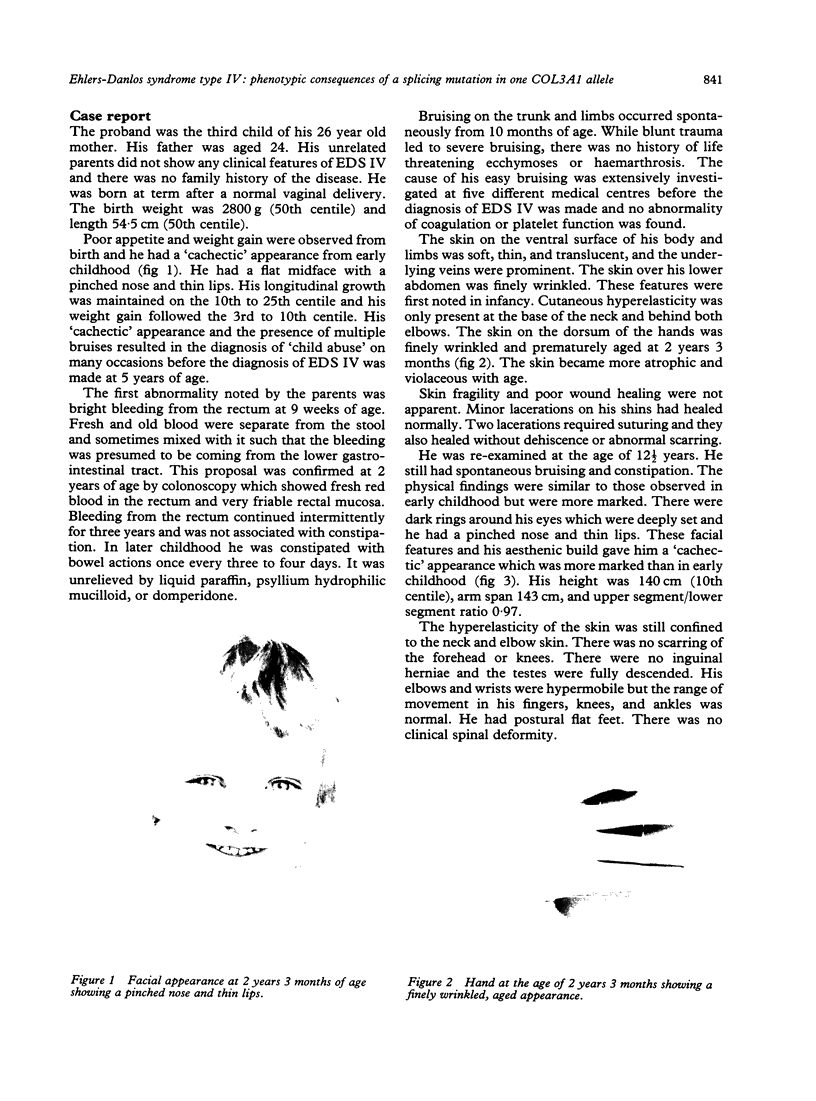
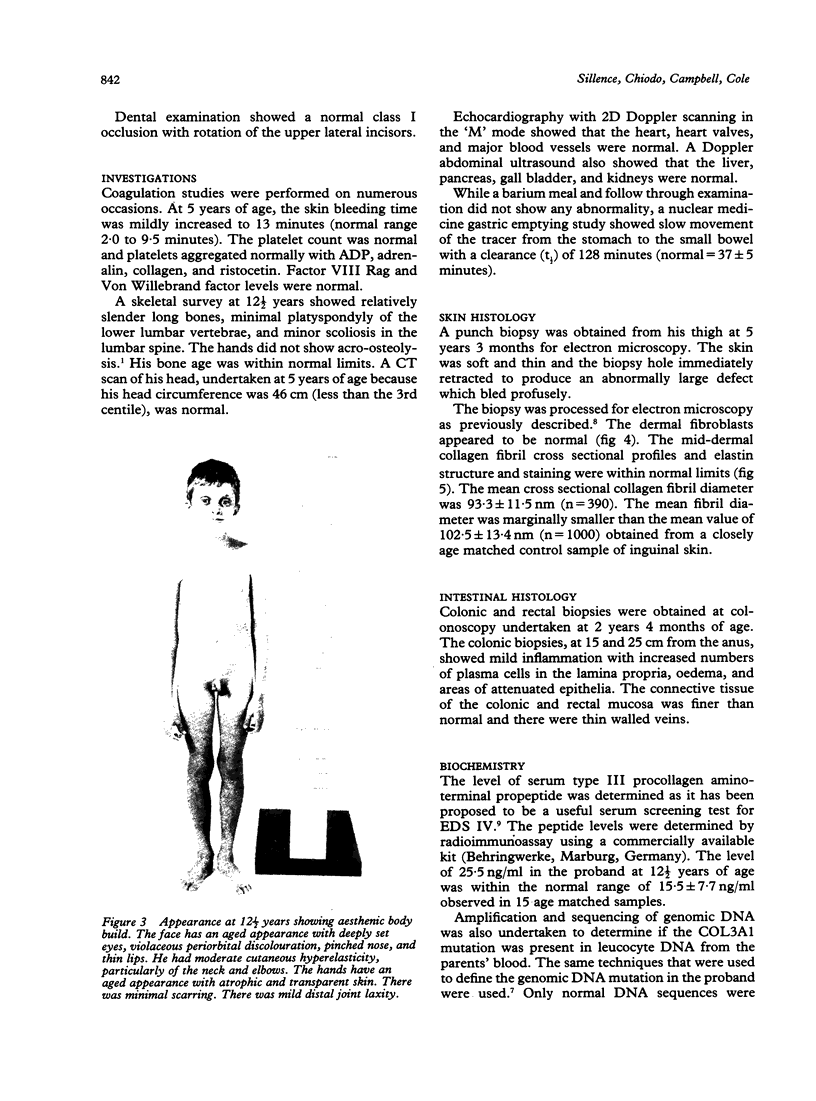
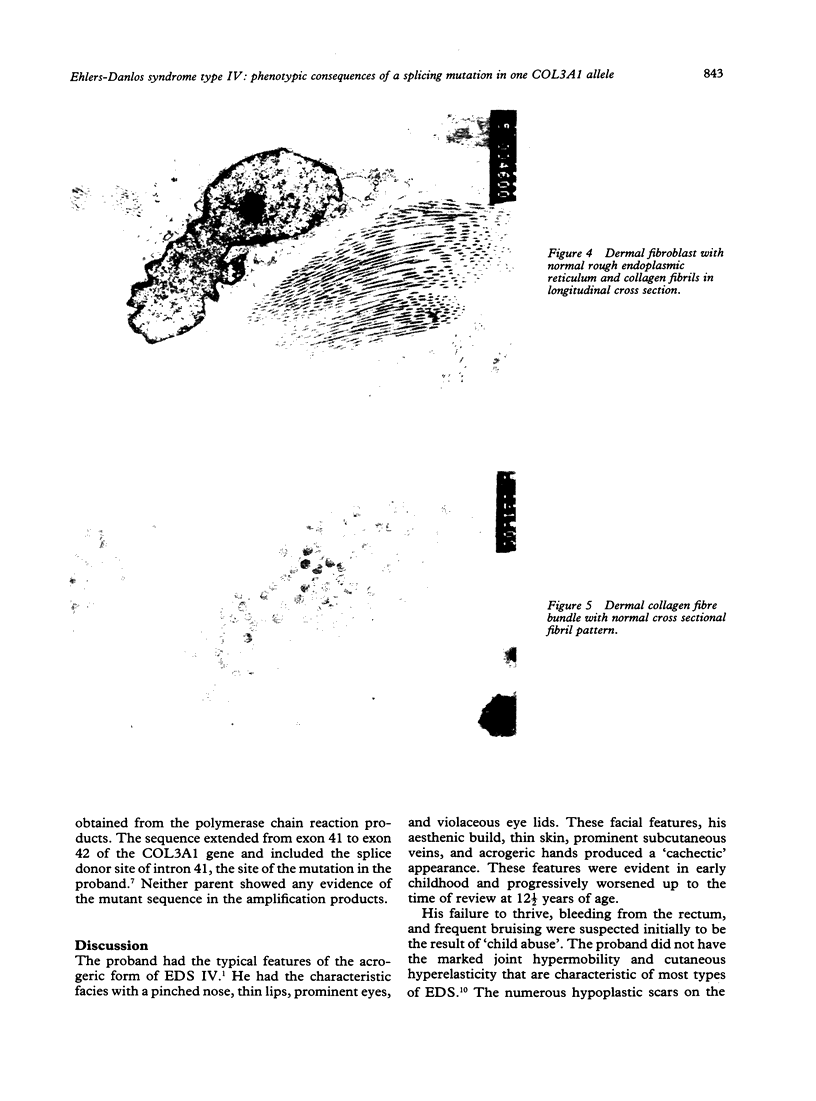
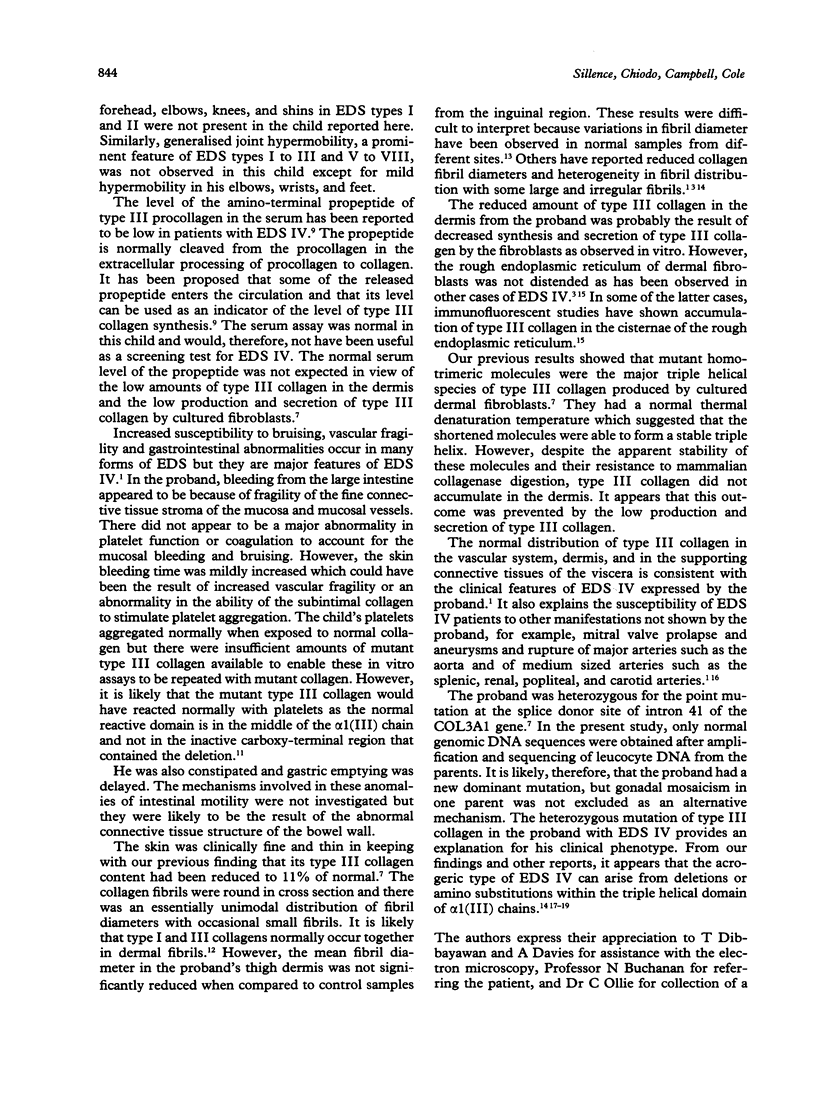
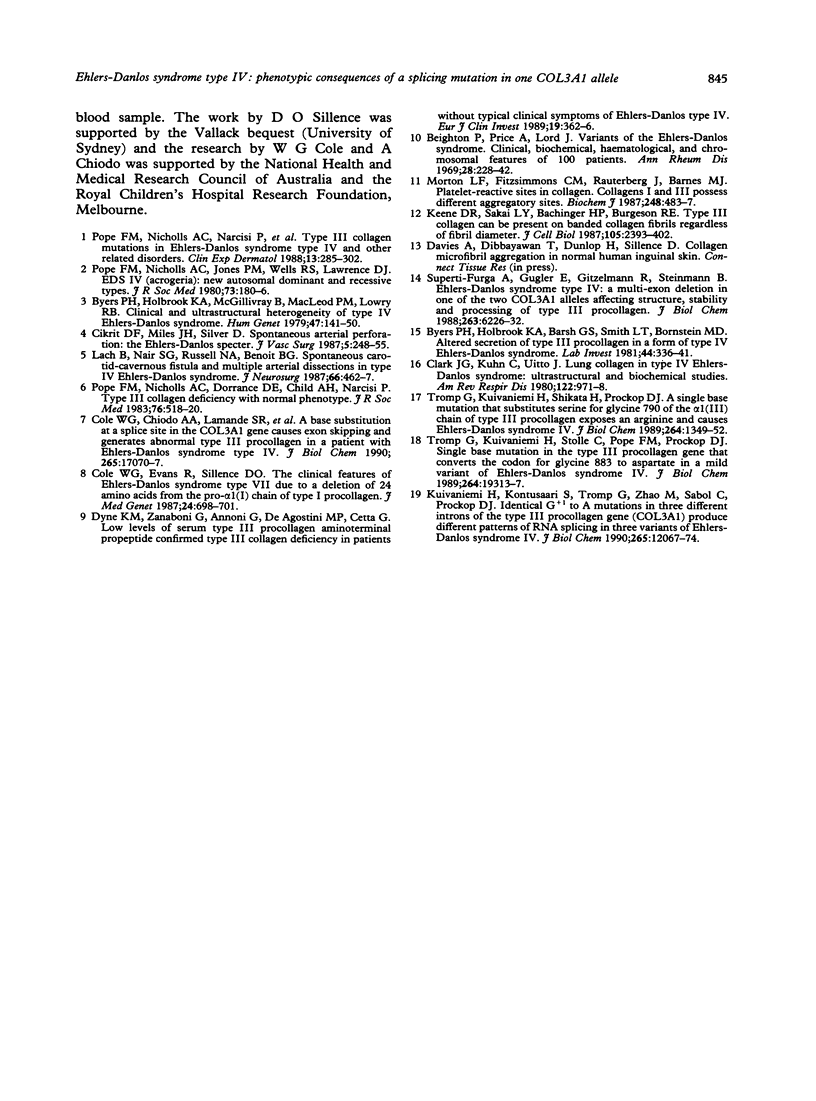
Images in this article
Selected References
These references are in PubMed. This may not be the complete list of references from this article.
- Beighton P., Price A., Lord J., Dickson E. Variants of the Ehlers-Danlos syndrome. Clinical, biochemical, haematological, and chromosomal features of 100 patients. Ann Rheum Dis. 1969 May;28(3):228–245. doi: 10.1136/ard.28.3.228. [DOI] [PMC free article] [PubMed] [Google Scholar]
- Byers P. H., Holbrook K. A., Barsh G. S., Smith L. T., Bornstein P. Altered secretion of type III procollagen in a form of type IV Ehlers-Danlos syndrome. Biochemical studies in cultured fibroblasts. Lab Invest. 1981 Apr;44(4):336–341. [PubMed] [Google Scholar]
- Byers P. H., Holbrook K. A., McGillivray B., MacLeod P. M., Lowry R. B. Clinical and ultrastructural heterogeneity of type IV Ehlers-Danlos syndrome. Hum Genet. 1979 Mar 12;47(2):141–150. doi: 10.1007/BF00273196. [DOI] [PubMed] [Google Scholar]
- Cikrit D. F., Miles J. H., Silver D. Spontaneous arterial perforation: the Ehlers-Danlos specter. J Vasc Surg. 1987 Feb;5(2):248–255. [PubMed] [Google Scholar]
- Clark J. G., Kuhn C., 3rd, Uitto J. Lung collagen in type IV Ehlers-Danlos syndrome: ultrastructural and biochemical studies. Am Rev Respir Dis. 1980 Dec;122(6):971–978. doi: 10.1164/arrd.1980.122.6.971. [DOI] [PubMed] [Google Scholar]
- Cole W. G., Chiodo A. A., Lamande S. R., Janeczko R., Ramirez F., Dahl H. H., Chan D., Bateman J. F. A base substitution at a splice site in the COL3A1 gene causes exon skipping and generates abnormal type III procollagen in a patient with Ehlers-Danlos syndrome type IV. J Biol Chem. 1990 Oct 5;265(28):17070–17077. [PubMed] [Google Scholar]
- Cole W. G., Evans R., Sillence D. O. The clinical features of Ehlers-Danlos syndrome type VII due to a deletion of 24 amino acids from the pro alpha 1(I) chain of type I procollagen. J Med Genet. 1987 Nov;24(11):698–701. doi: 10.1136/jmg.24.11.698. [DOI] [PMC free article] [PubMed] [Google Scholar]
- Dyne K. M., Zanaboni G., Annoni G., De Agostini M. P., Cetta G. Low levels of serum type III procollagen aminoterminal propeptide confirmed type III collagen deficiency in patients without typical clinical symptoms of Ehlers-Danlos type IV. Eur J Clin Invest. 1989 Aug;19(4):362–366. doi: 10.1111/j.1365-2362.1989.tb00242.x. [DOI] [PubMed] [Google Scholar]
- Keene D. R., Sakai L. Y., Bächinger H. P., Burgeson R. E. Type III collagen can be present on banded collagen fibrils regardless of fibril diameter. J Cell Biol. 1987 Nov;105(5):2393–2402. doi: 10.1083/jcb.105.5.2393. [DOI] [PMC free article] [PubMed] [Google Scholar]
- Kuivaniemi H., Kontusaari S., Tromp G., Zhao M. J., Sabol C., Prockop D. J. Identical G+1 to A mutations in three different introns of the type III procollagen gene (COL3A1) produce different patterns of RNA splicing in three variants of Ehlers-Danlos syndrome. IV. An explanation for exon skipping some mutations and not others. J Biol Chem. 1990 Jul 15;265(20):12067–12074. [PubMed] [Google Scholar]
- Lach B., Nair S. G., Russell N. A., Benoit B. G. Spontaneous carotid-cavernous fistula and multiple arterial dissections in type IV Ehlers-Danlos syndrome. Case report. J Neurosurg. 1987 Mar;66(3):462–467. doi: 10.3171/jns.1987.66.3.0462. [DOI] [PubMed] [Google Scholar]
- Morton L. F., Fitzsimmons C. M., Rauterberg J., Barnes M. J. Platelet-reactive sites in collagen. Collagens I and III possess different aggregatory sites. Biochem J. 1987 Dec 1;248(2):483–487. doi: 10.1042/bj2480483. [DOI] [PMC free article] [PubMed] [Google Scholar]
- Pope F. M., Child A. H., Nicholls A. C., Narcisi P., Dorrance D. E. Type III collagen deficiency with normal phenotype. J R Soc Med. 1983 Jun;76(6):518–520. [PMC free article] [PubMed] [Google Scholar]
- Pope F. M., Nicholls A. C., Jones P. M., Wells R. S., Lawrence D. EDS IV (acrogeria): new autosomal dominant and recessive types. J R Soc Med. 1980 Mar;73(3):180–186. [PMC free article] [PubMed] [Google Scholar]
- Pope F. M., Nicholls A. C., Narcisi P., Temple A., Chia Y., Fryer P., De Paepe A., De Groote W. P., McEwan J. R., Compston D. A. Type III collagen mutations in Ehlers Danlos syndrome type IV and other related disorders. Clin Exp Dermatol. 1988 Sep;13(5):285–302. doi: 10.1111/j.1365-2230.1988.tb00709.x. [DOI] [PubMed] [Google Scholar]
- Superti-Furga A., Gugler E., Gitzelmann R., Steinmann B. Ehlers-Danlos syndrome type IV: a multi-exon deletion in one of the two COL3A1 alleles affecting structure, stability, and processing of type III procollagen. J Biol Chem. 1988 May 5;263(13):6226–6232. [PubMed] [Google Scholar]
- Tromp G., Kuivaniemi H., Shikata H., Prockop D. J. A single base mutation that substitutes serine for glycine 790 of the alpha 1 (III) chain of type III procollagen exposes an arginine and causes Ehlers-Danlos syndrome IV. J Biol Chem. 1989 Jan 25;264(3):1349–1352. [PubMed] [Google Scholar]
- Tromp G., Kuivaniemi H., Stolle C., Pope F. M., Prockop D. J. Single base mutation in the type III procollagen gene that converts the codon for glycine 883 to aspartate in a mild variant of Ehlers-Danlos syndrome IV. J Biol Chem. 1989 Nov 15;264(32):19313–19317. [PubMed] [Google Scholar]



